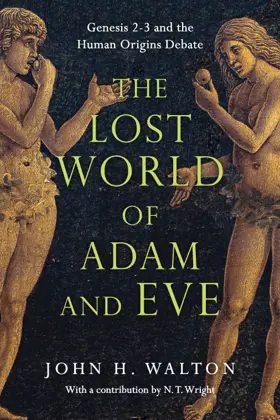

The Lost World of Adam and Eve: Genesis 2-3 and the Human Origins Debate
Pages
272
Publisher
IVP Academic
Published
2015
ISBN-13
9780830824618
For centuries the story of Adam and Eve has resonated richly through the corridors of art, literature and theology. But for most moderns, taking it at face value is incongruous. And even for many thinking Christians today who want to take seriously the authority of Scripture, insisting on a "literal" understanding of Genesis 2-3 looks painfully like a "tear here" strip between faith and science.
How can Christians of good faith move forward? Who were the historical Adam and Eve? And can we even begin to answer our questions unless we understand the cultural palette on which these epic colors were mixed and the brush dipped? In what cultural code was this couple, this garden, this tree, this serpent portrayed?
Following his groundbreaking The Lost World of Genesis One, John Walton now backlights this most elemental story with the ancient world of the biblical author. Walton gives us the context, insights and clarity to reset the discussion and move forward. As a bonus, an illuminating excursus by N. T. Wright places Adam in the implied narrative of Paul's theology.
The Lost World of Adam and Eve will be required reading for anyone seeking to understand this foundational text historically and theologically, and wondering how to view it alongside contemporary understandings of human origins.
How can Christians of good faith move forward? Who were the historical Adam and Eve? And can we even begin to answer our questions unless we understand the cultural palette on which these epic colors were mixed and the brush dipped? In what cultural code was this couple, this garden, this tree, this serpent portrayed?
Following his groundbreaking The Lost World of Genesis One, John Walton now backlights this most elemental story with the ancient world of the biblical author. Walton gives us the context, insights and clarity to reset the discussion and move forward. As a bonus, an illuminating excursus by N. T. Wright places Adam in the implied narrative of Paul's theology.
The Lost World of Adam and Eve will be required reading for anyone seeking to understand this foundational text historically and theologically, and wondering how to view it alongside contemporary understandings of human origins.
- Introduction
- Proposition 1: Genesis Is an Ancient Document
- Proposition 2: In the Ancient World and the Old Testament, Creating Focuses on Establishing Order by Assigning Roles and Functions
- Proposition 3: Genesis 1 Is an Account of Functional Origins, Not Material Origins
- Proposition 4: In Genesis 1 God Orders the Cosmos as Sacred Space
- Proposition 5: When God Establishes Functional Order, It Is "Good"
- Proposition 6: ’adam Is Used in Genesis 1-5 in a Variety of Ways
- Proposition 7: The Second Creation Account (Gen 2:4-24) Can Be Viewed as a Sequel Rather Than as a Recapitulation of Day Six in the First Account (Gen 1:1-2:3)
- Proposition 8: "Forming from Dust" and "Building from Rib" Are Archetypal Claims and Not Claims of Material Origins
- Proposition 9: Forming of Humans in Ancient Near Eastern Accounts Is Archetypal, So It Would Not Be Unusual for Israelites to Think in Those Terms
- Proposition 10: The New Testament Is More Interested in Adam and Eve as Archetypes Than as Biological Progenitors
- Proposition 11: Though Some of the Biblical Interest in Adam and Eve Is Archetypal, Yet They Are Real People Who Existed in a Real Past
- Proposition 12: Adam Is Assigned as Priest in Sacred Space, with Eve to Help
- Proposition 13: The Garden Is an Ancient Near Eastern Motif for Sacred Space, and the Trees Indicate God as the Source of Life and Wisdom
- Proposition 14: The Serpent Would Have Been Viewed as a Chaos Creature from the Non-ordered Realm, Promoting Disorder
- Proposition 15: Adam and Eve Chose to Make Themselves the Center of Order and Source of Wisdom, Therefore Admitting Disorder into the Cosmos
- Proposition 16: We Currently Live in a World with Non-order, Order and Disorder
- Proposition 17: All People Are Subject to Sin and Death Because of the Disorder in the World, Not Because of Genetics
- Proposition 18: Jesus Is the Keystone of God’s Plan to Resolve Disorder and Perfect Order
- Proposition 19: Paul’s Use of Adam Is More Interested in the Effect of Sin on the Cosmos Than in the Effect of Sin on Humanity and Has Nothing to Say About Human Origins
- Excursus on Paul’s Use of Adam, by N. T. Wright
- Proposition 20: It Is Not Essential That All People Descended from Adam and Eve
- Proposition 21: Humans Could Be Viewed as Distinct Creatures and a Special Creation of God Even If There Was Material Continuity
- Conclusion and Summary
- Glossary
- Further Reading
- Subject Index
- Scripture Index